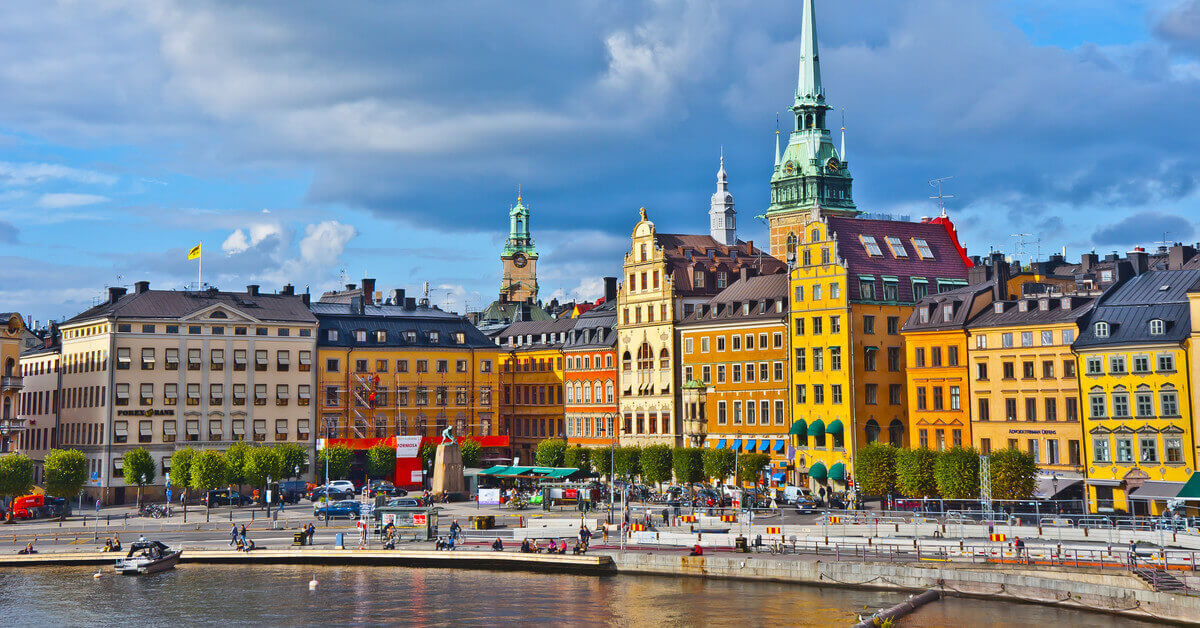What’s setting hotels in Sweden apart from those in others markets?
NB: This is an article form The Hotels Network
Amid the crisis that has swept up a storm for the hospitality industry as countries across the globe implement travel and mobility bans, Sweden has yet to order any lockdowns. Contrasting sharply with the rest of Europe and beyond, Sweden has only imposed relatively lenient restrictions, meaning that most hotels and restaurants remain open despite the COVID-19 situation.
Understanding the importance of focusing on the domestic market, securing direct bookings and maintaining ADR, these hotels have been employing practices to do exactly so. As countries, such as Spain and Austria, start to announce their plans for deconfinement, hotels in other markets may soon be finding themselves in a similar position as those currently open for business in Sweden. That is to say, operating within an industry that has been turned on its head and with a completely new set of challenges and dynamics; but open at least.
So now the question is: what can we learn from the experience of hotels in Sweden as restrictions start to lift gradually in other markets?
The hospitality scene in Sweden
Before we dive into the tactics Swedish hoteliers have employed to survive during these times, let’s have a look at the hospitality landscape in Sweden and how it may differ to some European markets.
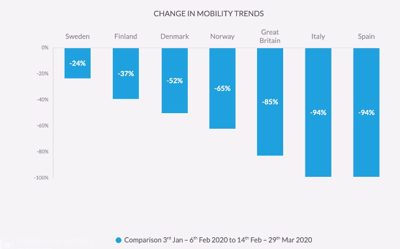
Source: Dagens Nyheter
Having restrictions not nearly as limiting as fellow European countries, the impact on Sweden’s hotel industry has been cushioned to a certain extent. Looking at the change in mobility from the beginning of the year to the end of the first quarter, Sweden has seen the least difference with only a -24% drop in contrast to Spain and Italy who have suffered from a -94% decrease in mobility.
Hotels in Sweden – Evolution of website visitors, bookings & conversion rate

Hotels in Spain – Evolution of website visitors, bookings & conversion rate

Looking at direct booking trends using The Hotels Network dataset, we can see that in March, hotels located in Sweden did not experience the sudden dramatic drop in booking engine traffic and direct bookings that was seen in Spain. Although there was a clear decline, the curve is more gradual with booking volume being supported primarily by domestic visitors, most likely due to their higher mobility. Conversion rates also showed signs of recovery at the start of April, helping to boost booking volume slightly.
In terms of rates, a recent study by Benchmark Alliance looking at the impact of the COVID-19 crisis shows that the ADR in cities such as Stockholm has remained relatively stable, suggesting that hotels have realized that slashing their rates will not be beneficial in the long-term. Instead of cutting rates, many hotels in Sweden have taken on a more proactive approach when it comes to shaping their game plan during the crisis.
6 strategies Swedish hotels are already putting into practice
In today’s challenging environment, many hotels in Sweden have turned to their direct booking channel and communication strategy, seeking to increase online conversions with guests, and putting themselves in an advantageous position for recovery. Here are six strategies Swedish hotels are employing now that could help inspire your marketing plan of attack as mobility starts to recover in your markets.
1. Providing peace of mind
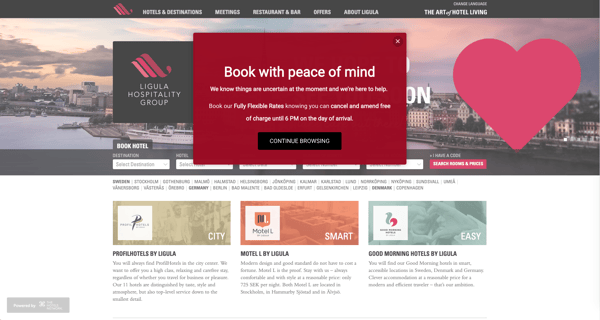
In a world where travel sentiment is quite sensitive, the first step to capturing online bookings should be to reassure visitors, and doing so boils down to the two words: communication and flexibility. You’ve probably heard this said a hundred times in the past weeks, but there is a good reason why companies and experts keep hammering home this important message. Making sure your online visitors know that you have implemented a worry-free booking policy can inspire trust and increase the probability of them moving forward with a booking. Ligula Hotels were quick to take action by grabbing the attention of users about to leave their website with an Exit Layer message, guaranteeing customers a safe booking thanks to their flexible cancellation and rebooking policies.
2. Promoting staycations to attract local travelers today
.png?width=600&name=image%20(26).png)
With incoming international travel very limited but local mobility relatively high, hotels in Sweden seized the chance to promote the idea of having a staycation. A contemporary and modern luxury hotel in central Stockholm, Hotel At Six by Nordic Hotels & Resorts, is putting the spotlight on the alluring experience they can offer locals. Creating a package for guests to feel pampered, the hotel offers the perfect staycation for those who need a break from everything going on at home. By using targeting options within The Hotels Network tool, the Layer message on the homepage is only displayed to visitors within Stockholm, enabling the hotel to show a personalized message to appeal to their local market.
3. Encouraging guests to book longer stays
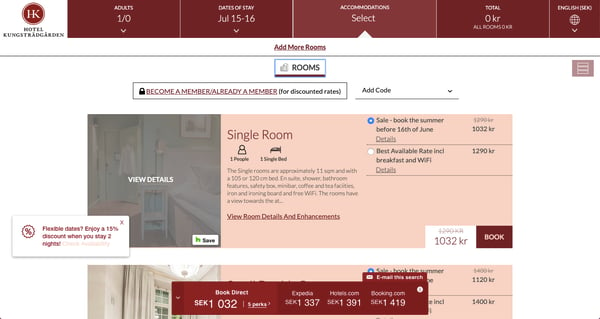
As sentiment to travel, especially international travel reduced significantly, it could be difficult for hotels to convince visitors convert. However, there isn’t nothing to be done. When faced with a much smaller level of demand, hotels are looking for ways to increase the average value of each booking they receive. An effective tactic to encourage longer stays is by offering benefits to guests already looking to book to incite them to book an extra night with you. With this in mind, Hotel Kungsträdgården launched a series of Smart Notes within their booking engine targeting visitors booking for 2 nights. The messages highlight the benefits of staying an extra one or two nights exclusively to those visitors, giving them motive to extend their booking. By using targeted messaging, hotels in Sweden are nudging guests that are already likely to convert to increase their booking value.
4. Driving immediate revenue through gift vouchers
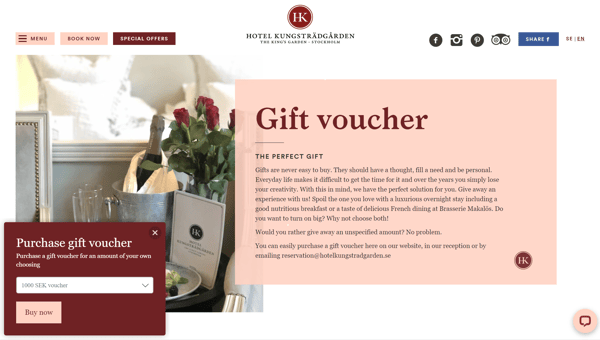
Making hotel vouchers available to visitors is a clever way to generate immediate revenue while current demand remains low. Hotel Kungsträdgården also launched a Welcome Layer to promote their gift card offers, encouraging guests to seize the chance to save 20% by purchasing a gift card today. Aiming to capture potential guests who are thinking about traveling after restrictions have loosened, promoting your hotel voucher offers will enable you to capture extra revenue while providing visitors with the incentive to stay with you in the future. For those who aren’t able to offer voucher offers yet on their hotel website, THN has recently released a voucher tool, allowing hoteliers to easily create and showcase their hotel voucher options.
5. Leveraging technology to make smart pricing decisions
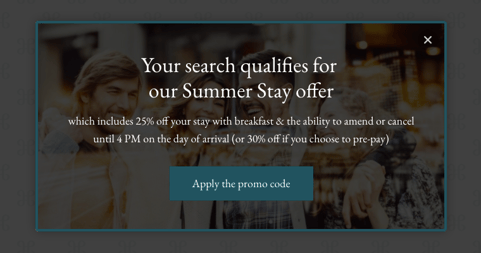
Offering some discounts or promotions to stimulate potential demand is certainly something you could build into your plan of action. However, offering a blanket sale to all your visitors might not be the smartest move. In Sweden, it appears that hoteliers have understood the importance of keeping their discount strategy under control to maintain a high ADR.
One tactic is to leverage AI technology, such as our machine learning product Oraculo, so you can segment your hotel website traffic in real time based on purchase intent, ranging from low-intent users (those who are unlikely to convert) to high-intent users (those who are most likely to convert). The technology enables you to automatically personalise the website experience for each visitor with the strongest and most relevant messaging and offer. This means that you can decide to only show offers to users who really need an extra incentive to make a booking, generating savings in promotional costs. Conversely, instead of offering discounts to high-intent users who are likely to make a booking anyway, you can communicate up selling messages such as promoting a higher room category or longer stay to boost average booking value.
6. Building a strong community of followers
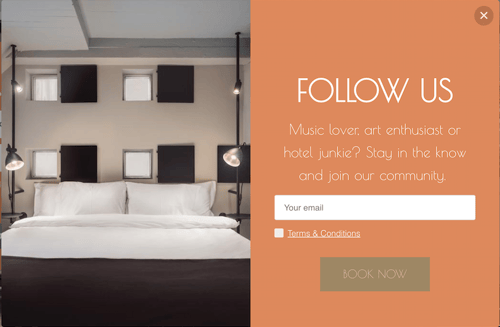
Other than capitalizing on whatever travel demand there is to secure direct bookings, now is a good time to think about how you can build a strong pool of loyal followers for the future. Unsurprisingly, in Sweden, hotel website booking conversion rates have taken a hit these past weeks, albeit slightly less than in other markets. With increased uncertainty in the minds of visitors, many are not ready to confirm a reservation today, but hotels are finding other ways to generate engagement with their website visitors. The above example shows a hotel taking advantage of our new subscription feature to launch an integrated Layer to capture emails and grow their base of newsletter subscribers. Given the current situation, it makes sense to collect opt-in subscribers to be able to keep visitors updated by email about any developments at your hotel or exclusive offers. By continuing to nurture followers in this way, moving forward you can hopefully convert more website visitors into loyal brand advocates.
Much can be learned from the experience of Swedish hotels during a time when properties are open but travel restrictions are still in place. Being mindful of the bigger picture, they’ve shaped their strategic plan with specific goals in mind. Despite the current drop in international travel and demand, these hotels have fine-tuned their marketing tactics to help them weather the storm.
It’s never too early to start planning your next steps. No matter if your property is closed or still open for business, your website is always there as your most important window to communicate with guests and potential guests, with its content potentially needing to be updated daily. Now is the time to make sure you are ready to switch on carefully crafted, personalized marketing campaigns the very second you have confirmation of when your hotel doors will reopen or when you see the first green shoots of recovery in travel intent within your markets.

